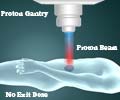Head and neck cancer patients treated with intensity modulated radiation therapy (IMRT) report better quality of life post-treatment, reveals study.

Investigators from the University of California, Davis, School of Medicine, prospectively administered the University of Washington Quality of Life instrument, a standardized, previously validated questionnaire that patients complete after radiation therapy, to 155 patients undergoing treatment for cancers of the head and neck and analyzed the scores over time. Fifty-four percent of patients were initially treated with IMRT and 46 percent were treated with non-IMRT techniques.
The researchers showed that the early quality of life gains associated with IMRT not only are maintained but become more magnified over time. At one-year post-treatment, 51 percent of IMRT patients rated their quality of life as very good or outstanding compared to 41 percent of non-IMRT patients. However, at two-years after treatment, the percentages changed to 73 percent and 49 percent, respectively. Also, 80 percent of patients treated with IMRT reported that their health-related quality of life was much better or somewhat better compared to the month before developing cancer. In contrast, only 61 percent of patients treated by non-IMRT techniques felt similarly.
Although the researchers acknowledged that quality of life is somewhat of a subjective concept, they nonetheless believe their findings support the widespread use of IMRT for head and neck cancer.
"Hopefully, these results provide some reassurance to patients that radiation therapy using contemporary techniques in the hands of expert specialists can maintain their function and long-term quality of life, while still curing them of cancer," Allen Chen, MD, lead author of the study and director of the radiation oncology residency training program at the University of California, Davis School of Medicine in Sacramento, Calif., said.
"Radiation therapy for head and neck cancer is without a doubt an intensive process and very intimidating to most patients. Folks think about the prospects of six to seven weeks of radiation and naturally expect the worst. It is nice to know that technological advances have made the treatment much more tolerable than in the past."
Advertisement















